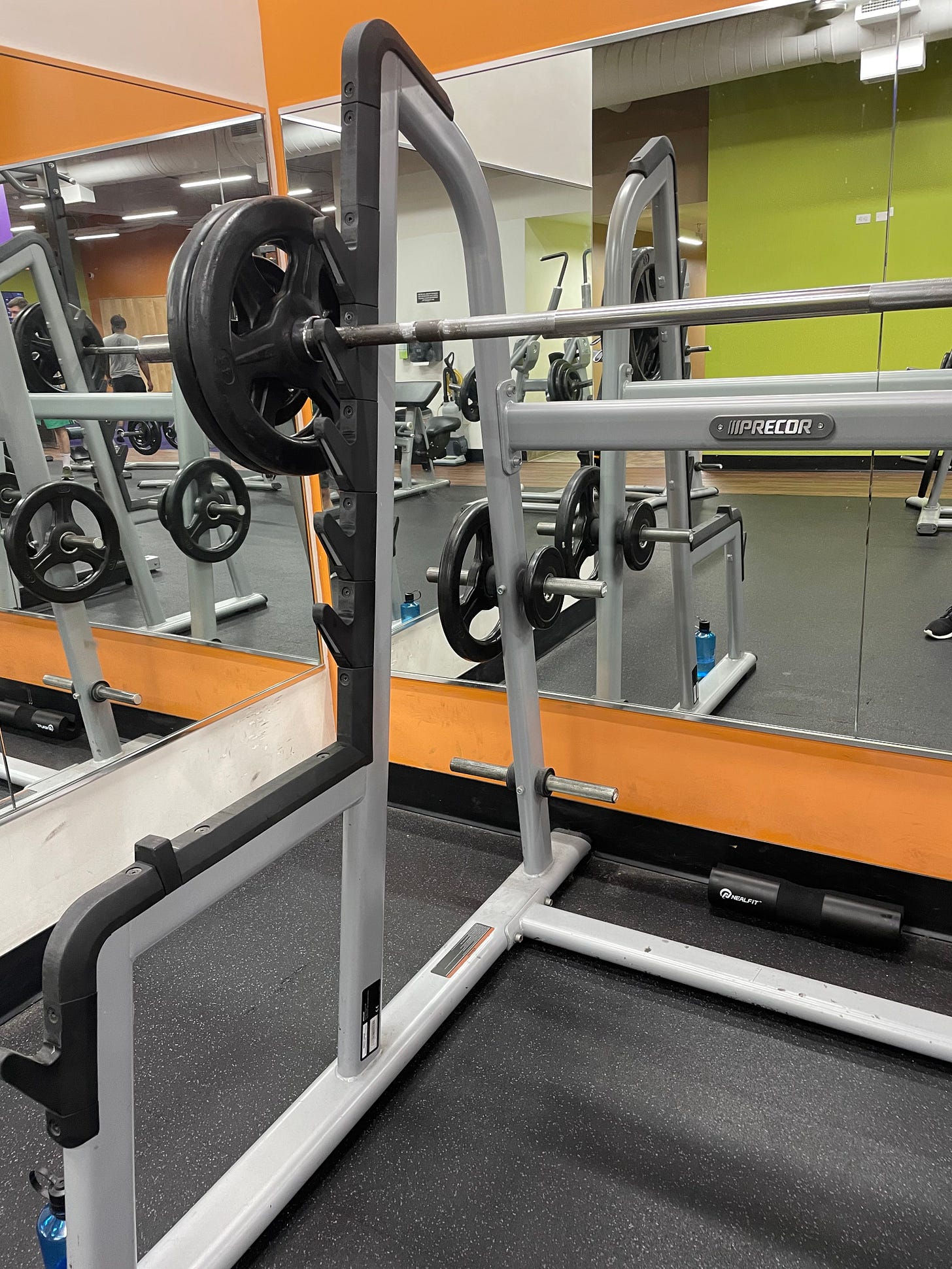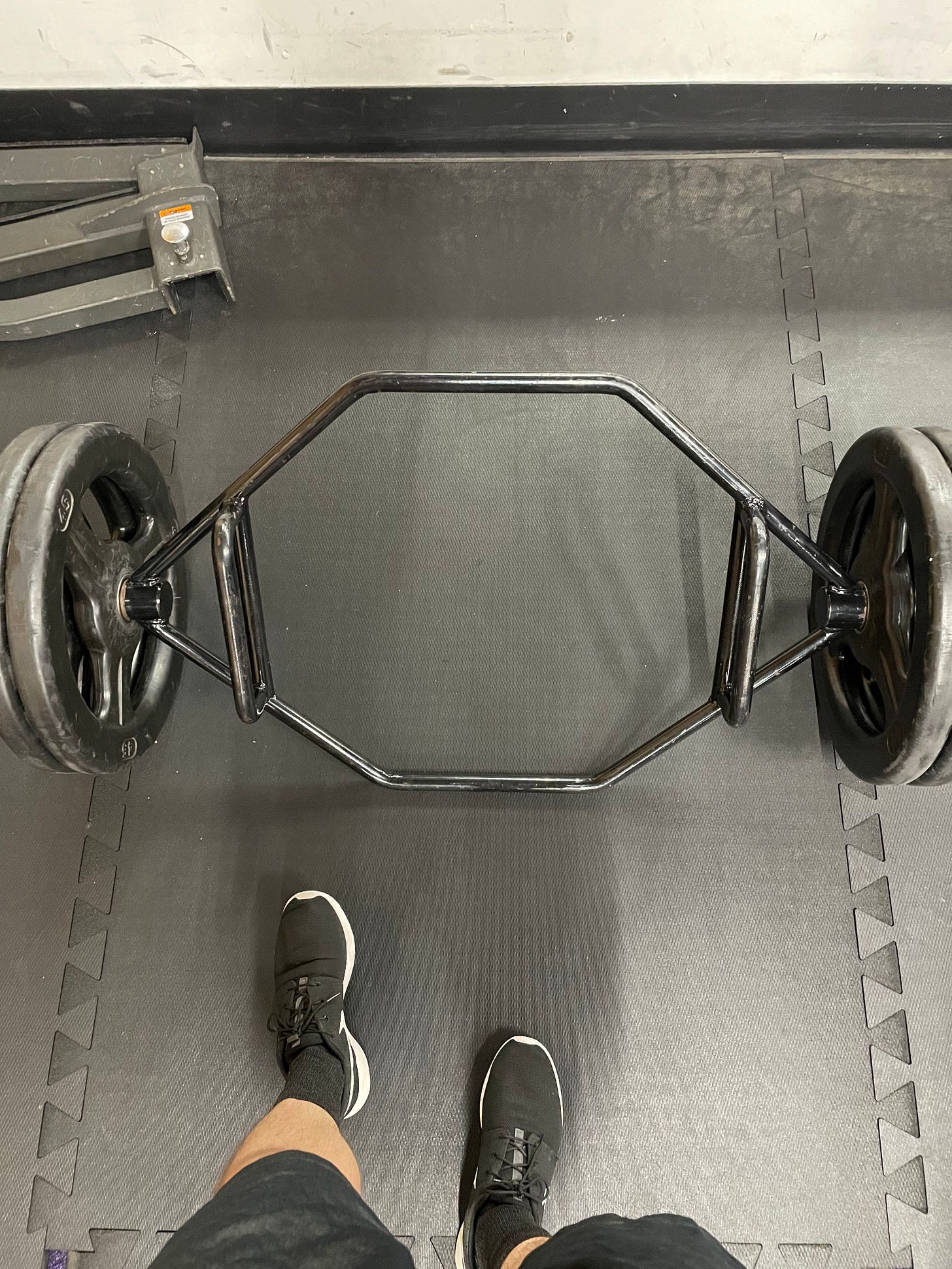Base training is the absolute most foundational part of my schedule, both in season and during the offseason. But what’s the first thing to add to it in the offseason? Today we’re talking weightlifting. As a reminder, here’s where we’ve been and where we’re going over the next few weeks.
Part 3 – Weightlifting
Oh, and make sure you’re subscribed so you don’t miss any of it!
Build Strength to Go Faster and Further
There is something counterintuitive when first approaching weightlifting as a cyclist. Cycling is an endurance sport; doubly so for the kind of cycling I talk most about here. It rewards being light and wiry. When you say “weightlifter,” the first think that probably springs to mind is something like a bodybuilder. Combine the two and you end up with a farcical image like this:
But weightlifting for cycling isn’t about getting huge. It’s about getting strong. Because getting strong means A) you can push on the pedals harder, and B) pushing the pedals harder feels easier than it did before.
As I said in the intro to this series on offseason training, this is borrowed expertise plus my own subjective experience. But without question, research shows that weightlifting can help cycling performance. The goal here is to build as much strength as possible without adding significant muscle mass. And to do that, we have to keep reps low and weight high.
Lift Heavy
This can be a scary thing. It certainly was for me when I started lifting this way. Trying for eight, ten, twelve reps per set feels safe – the weight you’re lifting when trying for these sorts of reps isn’t going to overwhelm you. It’s also how to target hypertrophy – growth of muscle volume. That’s no good for cycling.
Instead, we’re after strength. That means adding enough weight on key exercises that you’re eking out about four reps per set, and certainly not exceeding six reps. For my heavy lifts, I do four sets per exercise, making sure to take a few minutes of rest between each set. (I go as far as setting myself a three minute timer, which is honestly on the short side for this kind of lifting. Recovering is important to get the benefit out of each set, and sitting in the gym doing noting can feel uncomfortable enough to rush you if you don’t have an objective measure like a timer.)
Although I will do a separate warmup at the start of my gym session, my first set of my heavy lift is usually an exercise-specific warm up of sorts. I’ll start with a set at 70-80% of my target weight, do the next two sets at my target weight (bumping the weight up in small increments if I’m hitting the six rep max), and performing the last set at just over my target weight, even if I only manage 2-3 reps, to make sure I’m pushing myself appropriately.
Squats, leg presses, and deadlifts are king for targeting the big muscle groups cyclists use the most. If these movements are new to you, PLEASE go watch some tutorials on proper form and then ease into them to understand not only how the weight feels as you go through these exercises, but where you might have a weakness in your kinetic chain. When I started doing heavy squats, it took a couple months for my back to catch up with my legs. I needed to build up the stability required from the rest of my body in order to properly challenge the muscle groups I was targeting.
I prioritize squats in my own training plan, but also regularly perform leg presses to make sure that I’m challenging my legs even when the rest of my body can’t fully keep up. In my 2023-2024 offseason, I didn’t incorporate deadlifts (I had done so in ’22-’23) because the weak point became my grip, shoulder, and upper back strength, and therefore I was skeptical of the leg benefit. I had actually strained an intercostal muscle in early 2023 doing deadlifts, which scared me off a bit.
However, I’m going to reincorporate some deadlifts this offseason because I think that my top-to-bottom body strength was a point of relative weakness this year. I favor trap bar deadlifts vs normal barbell deadlifts since the trap bar variation is safer for your back and better targets the quads. Another point of self-emphasis this year is single leg variations on key exercises. Normal squats and such will still make up the majority of my heavy lifting, but I want to ensure I’m giving time to single leg squats and leg presses to build stability in my legs and work on any imbalances I may have.
By the way, the reason you want to start gym work in the offseason is that you are going to be EXTREMELY sore for the first couple sessions and may need some extra rest time at first. I’m writing this the day after my first heavy gym session in months, and certain normal, everyday movements feel murderous today. The soreness will go away and stop being an issue if you’re consistently doing heavy sessions.
Wraparound Core Strength
A strong core is required to safely lift heavy; it’s also a key factor in delivering power and being comfortable on your bike.
A strong core doesn’t just mean doing crunches forever, though. This kind of contraction movement has a role in core strength, but the target is really core rigidity. Core strength is like a built-in brace around your spine and all the sensitive nerves and discs up in there. You want to get good at resisting movement across different planes of motion.
For this reason, planks, hollow body holds, and various kinds of bridges are great exercises. I try to keep a large bench of core exercises so that I’m constantly challenging my core in new ways, but there are a few that take a higher priority in my workouts. If any of these are new to you, check out the links.
High Priority Core Exercises
The important thing here is trying always to work abs, obliques, and back to build strength all the way around my spine. Most of these exercises are also pretty easy to scale up beyond just adding reps or time. For example, planks can be made more challenging by adding a slow march; table extensions are tougher with a resistance band.
I want to take just a moment to call out weighted marches since this is probably the exercise on this list least familiar to people. This may look like nothing, but it is one of the most effective core bracing exercises I have ever done, and it’s incredibly scalable. Find a way to fit it into your routine.
Joints Should Be Wiggly, But Not Floppy
I rate this next set of exercises as slightly less important to outright performance, but something you neglect at your own risk: mobility and stability, especially of the hips, knees, and ankles. If you have pain, soreness, or discomfort after a ride and your bike fit is good, chances are you’re getting strain referred from tightness somewhere through this chain.
Everyone’s needs are different, but the principle is pretty much the same regardless of what body part you’re targeting. Building not just flexibility, but strength through a range of motion, will help you develop lasting, useful mobility. For me, I do several banded exercises for my hip strength, plus bodyweight motions like pistol squats and single leg (low weight) deadlifts as well as a range of exercises using a bosu ball to challenge my stability.
If this is new to you, or if you need help targeting a specific area, I’ve found these channels to be both helpful and inspirational:
Don’t get too hung up on volume here or overwhelmed by the sudden urge to properly mobilize everything. I work some stability drills that require more space or equipment into my gym days, but I find a lot of value in rotating through a few 10-25 minute mobility workouts several times a week at home. It’s been a challenge for me to find time to keep mobility in my training plan, so breaking it down into these extremely compact units allows me to fit mobility into my days without needing to dedicate “a workout” to them. I’ve tried to make a habit of doing this tiny set of mobility (plus a touch of core work) first thing in the mornings, but by keeping the workouts short they’re easy to fit in at lunch, in the evenings, whenever. Keep it small and you’ll see benefits without it (hopefully) becoming a burden.
Do Cyclists Even Have an Upper Body?
I will admit to neglecting my upper body last year. Yes, I’d do a few pull ups or push ups each time I was in the gym. That was it, though, and I do think it was one (of several) contributing factors to my neck issues during the Mishigami Challenge this year.
So this year, I’m going to bring back just a bit more upper body work. Since I’m trying to build stabilizing strength and endurance rather than pure lifting power or mass, there are two principles that are guiding my work here:
Balance “push” and “pull” exercises in the up/down and fore/aft planes
Use bodyweight exercises; or when using other weights, aim for 20-30 reps to target muscular endurance
In short, I’ll keep doing push ups and pull ups (and doing them a little more often), but I’ll also add a few exercises like military press, cable rows, dips, and reverse flys. These will get peppered into my gym days as a sort of rest between my heavy leg exercises and my stability exercises.
Knowing Where I’ve Been To See Where I’m Going
I’ll be willing to bet most of you use some sort of tracking app to record your rides, whether with a phone or cycling computer. Whether you’re a data nerd or you just like to see how far you went, tracking your rides helps you see progression.
The same is true with weightlifting, and since weight and reps are so important to making progress, maybe even doubly so. After a few times in the gym, you shouldn’t be guessing about how much weight you should squat to hit that 4-ish rep magic number. Same with trying to hit 25 reps on a military press, or remembering how many pistol squats you’re trying to do. Hard data will help you progress, even accounting for day-to-day performance variations. (I have had many days in the gym where I simply had fewer reps in me at a given weight than normal. Don’t get hung up on it.)
This can absolutely be as simple as a piece of paper. Print yourself a spreadsheet with your workout. Keep a list in a note on your phone. I use a fitness tracking app that helps me keep reps, weight, and other notes in one place a little more easily, but the point is simply that tracking your performance will help you get the most out of your workouts. AND, you’ll get to feel good about how much progress you’ve made by the end of the offseason.
My Offseason Weightlifting Plan
2x/wk in the gym
60-90mins per workout
Example:Warmup
2-4 core exercises x 1-2 sets
1 heavy leg lift x 4 sets
2-4 upper body exercises x 1-2 sets
2-4 stability exercises x 1-2 sets
2-4 different core exercises x 1-2 sets
3-5x/wk at-home mobility and core
10-25 minutes per workout





